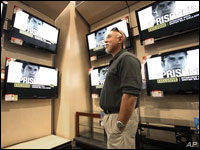
As Amazon’s Fire Phone finds its way into consumers’ hands, brick-and-mortar retailers are on guard. Amazon’s new device is equipped with technology that seems to have been designed to take showrooming to new heights — or depths, depending on one’s perspective.
The Fire Phone, in brief, has functionality that lets users scan an item they see in front of them or in a magazine. The device identifies the item and then presents the shopper with the opportunity to purchase it online — at the Amazon store.
The potential impact on brick-and-mortar shopping seemed ominous — so it was with great delight that retailers greeted a new A.T. Kearney report that found the dominant shopping channel — by far — is still the physical retail store.
Some 90 percent of all of last year’s retail sales were made through a brick-and-mortar store, A.T. Kearney found.
Still, the firm is hardly dismissing the importance of e-commerce and m-commerce to the retail ecosystem.
A Tightly Integrated, Omnichannel World
In fact, e-commerce, m-commerce and brick-and-mortar shopping are tightly interrelated, according to Michael Brown, A.T. Kearney partner and co-author of the Omnichannel Shopping Preferences Study, which was released last week.
Actually, they are more than just tightly interrelated. These various retail channels are so intertwined that it has become difficult if not impossible to tease them apart.
A sale can begin life as online research conducted on a desktop, then advance with a trip to a physical store where the consumer checks out the merchandise, A.T. Kearney explains in its study. The consumer then might return home to purchase the item in question online — or not.
Even though the shopping began online, brick-and-mortar retailers will assume that any sale concluded online was “stolen,” simply because the consumer at one point entered their store.
However, there is research to show that consumers begin shopping online often do make their purchase in a store — aided and abetted by those mobile devices retailers so detest.
There also are studies that show consumers who decide to conclude the purchase of the showroomed item online often buy something else while at the brick-and-mortar store — impulse purchases they otherwise would not have made.
There are so many shopping permutations, and the tracking of an individual consumer’s behavior is so difficult — yes, even in a post Edward Snowden world — that the only certainty is that all the channels likely play a role in purchase decisions.
This is a lesson that seems lost on publishers, book authors and Amazon, as they wage their e-book pricing war. As an avid reader and long-time Kindle owner, I can tell you I have downloaded a forest’s worth of e-books that I never would have bought in an actual store, thanks to the device’s excellent search functionality. These are extra sales — not online sales “stolen” from the corner book store.
A Confluence of Events
Showrooming got a bad rap because it became prevalent around the time the Big Box retailers — Circuit City, Best Buy and the like — started to have difficulties.
It just so happened that retailers that sold commodity electronics were most easily hurt by the practice. It also just so happened that it occurred during the peak of the Great Recession, when an awful lot of businesses were going under.
Showrooming did push many retailers into developing more consumer-friendly processes and policies, and to reimagine their stores’ layouts. Like many disruptions, it ultimately was good for the majority of people — in this case, consumers, not retail workers.
Retailers are starting to accept the complementary role e-commerce and m-commerce play in the sales process, but now it is time for them to fully embrace and integrate these various strategies, which often still operate in silos. Although the A.T. Kearney report speaks of the “omnichannel,” that term may become archaic surprisingly fast, according to Brown.
It suggests that the retailer still cares about the channel in question, he points out. Now, don’t get him wrong — retailers need to keep on top of the latest technologies in order to cultivate all shopping channels. More importantly, they need to service customers through all the channels and not just a select few.
In the end, the retailers that truly will reign supreme in an omnichannel world will be the ones that don’t think about channels at all, Brown said. Instead, they’ll “just focus on the customer.”
























































